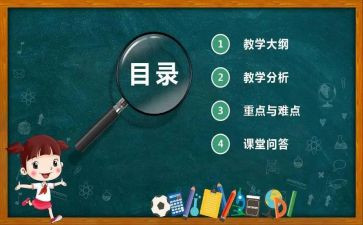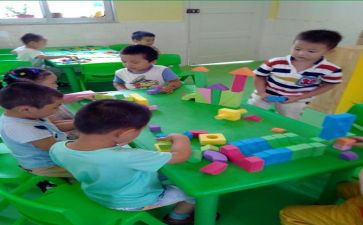英语说课教案模板8篇
无论写什么样的教案,教师们都要提前设定好自己的教学目标,教案在书写的时候,老师务必要强调与时俱进,小文学范文网小编今天就为您带来了英语说课教案模板8篇,相信一定会对你有所帮助。

英语说课教案模板篇1
unit1hello
教学目标与要求:
1、能听懂,会说hello./hi.goodbye./bye.i’m?what’syourname?myname’s?并能够在实际情景中进行运用。
2、能够听说,认读crayon,pencil,pen,eraser,ruler,pencilbox,book,bag.并能用英语介绍文具。
3、能听懂所接触的指示语,并能按照指令做出相应的动作。
a部分
第一课时
一、教学内容与分析
1、let’stalk
本部分主要是会话学习。通过见面打招呼,自我介绍等情景,让学生在模仿、学习、表演的基础上逐步达到自然交流与真实运用的目的。
2、let’splay
本部分让学生在游戏活动中熟练运用所学问候语及自我介绍用语。
3、let’ssing
本部分主要通过学生学唱abcsong,让学生初步接触字母的发音,激发他们对英语学习的兴趣,从而逐步培养学生的语音,语调。
4、let’sfindout
通过找字母,让学生了解字母。
二、课前准备
1、将教师用书后所附的本套教材主要人物的图片复印或剪下,涂色后制成头饰。
2、为班上学生准备出男女生常用的英文名字。
3、为let’splay中的游戏准备相应的道具。
三、教学步骤
?一】热身(warm-up)
不妨请学生说说他们在现实生活中已经了解的英语词汇或日常用语。同时可利用我们生活中学生已经会说或较熟知的词汇如tv,cd,vcd,dvd,ok!hi!yeah!bye!cool!wow!e-mail,cartoon等等来激发学生想学英语的兴趣和愿望。
?二】新课展示(presentation)
新课展示一:
教师播放本课的歌曲“hello”的录音,自然引出师生之间的打招呼。
(1)通过教师的自我介绍自然引出hello,i’m?/hi,i’m?
(2)教师可戴上sarah的头饰介绍hello!i’msarah.并用同样方式介绍其他人物。
(3)让学生到讲台上来,戴上sarah,chenjie,mike的头饰说:hello!i’m?
(4)教师戴上wuyifan的头饰说hi!i’mwuyifan.并与戴sarah头饰的学生相互问好,并有意在分手时说goodbye.
(5)听录音来展示let’stalk部分的教学内容。
?三】趣味操练(practice)
趣味操练一:
(1)请戴着wuyifan,chenjie,sarah,mike头饰的学生站在讲台前,另选一同学用眼罩蒙住眼睛,让sarah等四位同学中的一个说hello,让蒙住眼睛的同学猜。如果猜中,要说yes,i’m?如果猜错,要说no,
i’m?猜对得一分。
(2)表演a部分对话,教师应指导学生注意语音,语调,特别是i’m的发音,应为/aim/不能读成/em/.
(3)玩let’splay中的游戏“击鼓传花”。
新课展示二:
教师播放let’ssing两遍,学生边听边跟唱,让能力强的学生唱一遍,教师适当进行奖励或表扬。
教师领唱,学生跟唱,全体同学一起唱。分小组唱,对于唱得好的小组进行表扬。
趣味操练二:
(1)请学生在限定时间内找出在小村庄里出现的字母,对于找得又快又好的的学生要加以奖励,有能力的学生让他们读出这些字母。
(2)教师和学生一起校对。
(3)让学生跟随录音一起学唱歌曲abcsong.
?四】课堂评价(assessment)
要用hello!/hi!打招呼并作自我介绍。
?五】课外活动(add-activities)
(1)听录音,仿读会话,并在实际情景中运用所学内容。
(2)遇到老师、同学和家长时要用hello!/hi!打招呼;分手时要用goodbye./bye-bye.道别。
第二课时
一、教学内容与分析
1.let’slearn
本部分主要学习4个有关文具的词汇:pencil,ruler,eraser和crayon.
2.let’schant
本部分通过ihaveaan?的歌谣,练习并运用以上单词。
二、课前准备
教师自备与本课相应的文具(实物)和单词卡片。
三、教学步骤
1、热身/复习(warm-up/revision)
(1)演唱歌曲abcsong。
(2)请几个学生戴sarah,wuyifan等人物的头饰,两人一组打招呼问候:
sarah!hi,wuyifan!
(3)让学生之间互相打招呼问候(用自己的英文名字或中文名字)。
(4)将学生分组进行自我介绍。
hello,
2、新课展示(presentation)
(1)给学生出示文具实物,教新单词pencil,ruler,crayon,eraser.教师边教边作示范。如pencil一词,教师可通过实物或图片介绍新词,带读并示范,让学生在ihaveapencil.的指令下出示铅笔。可用同样的方法教本课时的其他文具。(教学中,教师要特别注意crayon及eraser两个词的发音。对于多音节词,教师可采取“先部分,后整体”,分音节的方法进行教学。例如教eraser一词,教师先示范整个单词的读音,然后分音节请学生跟读e-ra-ser,最后再让学生跟读整个词,此时教师要注意学生把重音放在第二个音节/rei/上。)
(2)让学生听录音,跟读let’slearn部分的词汇,并要求学生用手指着词汇来认读,力求做到“眼到、手到、口到、心到”。
3、趣味操练(practice)
(1)游戏活动
a、“寻宝藏”:让一学生面向黑板,另一学生把教师准备好的宝藏(即本课时的学习用具)藏到其他同学的书桌里,寻宝藏的同学开始寻宝,全班学生读该单词,当寻宝的学生离宝藏较远时小声地读,当寻宝的学生离宝藏较近时大声地读。b、猜物品游戏:将crayon等文具放在一个大盒子里,请一们同学出来选一样文具攥在手里放在背后(2)让学生听录音,边说边做let’sdo部分的活动。
4、课堂评价(assessment)
做活动手册本单元第2部分练习
5、课外活动(add-activities)
听说、认读新单词pencil,pen,ruler,eraser,crayon,并能用英语介绍文具。教学反思:
英语说课教案模板篇2
教材分析
本课是新标准英语三年级起点第四册第五模块的第一单元,本单元真实地通过同学之间的比较,让同学很好地理解比较级的句型用法。要求学生掌握than,old,young,strong 等词,并能运用heshe is +比较级+than……句型进行教学活动。通过使用图片、多媒体课件及创设真实情景的方法,有效地操练句型。
学情分析
学生能用简单的英语互致问候,交换有关个人、家人和朋友的简单信息,有一定的英语语言运用能力,在课堂上采用情景式教学,引发学生的兴趣以达到教学目标。
教学目标
一、情感态度与价值观
1.运用图片和实物,通过视听法和交际法等教学方法,创设情景对话,引导学生在感知、体验和参与中学习英语,激发兴趣。
2.培养学生关爱弱势同学,同学之间互助友爱的精神。
二、过程与方法
1.学习新单词old、young、strong、than
2.初步认识形容词比较级taller、shorter、older、younger、stronger.
三、知识与技能
1.学会运用形容词比较级的句型:…-erthan
2.培养学生自主探究学习的能力。结合生活实际及学生感兴趣的事物进行比较。
教学重点和难点
1.单词than 及其它形容词的运用。
2.功能句:amy is taller than lingling.
3. 能够灵活运用形容词来描述比较两者之间的差异
英语说课教案模板篇3
lesson plan interpretation
nsefc book1 unit3 travel journal
hello, everyone. it’s an honor for me to stand here and interpret my lesson. the lesson plan i am going to talk about is from nsefc book 1 unit 3 travel journal. i’ll explain how to teach and why do so from the following 5 aspects: the theoretical basis, understanding of the teaching material, teaching methods and studying ways, teaching procedure, blackboard design.
Ⅰ. the theoretical basis
first, i’d like to show my theoretical basis--schema theory and top-down model (goodman, 1971). journey down the mekong is a reading course. according to schema theory, reading comprehension is an interactive process between the reader’s background knowledge and the text (carrel and eisterhold, 1983), or between the new information and the old knowledge store (anderson and pearson, 1984). so in order to improve the students’ reading speed and reading comprehension, language teachers should try to activate the ss’ old knowledge store and add more relevant background knowledge before they get the students to read. according to the top-down model, general idea of the text will be got first, and then come the details.
ii. understanding of the teaching material
my understanding of the teaching material includes 3 parts: the status and the function, teaching objectives, the important and difficult points.
at the beginning, let’s focus on the first part. journey down the mekong is a piece of travel journal written by wang kun. it’s mainly about wang kun and his sister’s dream of taking a great bike trip down the mekong river, their preparation for the trip and some more details of the mekong river. general speaking, it is not difficult for the students to understand the text, but there are some new phrases and sentences that may be a little bit difficult. so before the students’ first reading, i will explain the new words and phrases briefly and after reading the whole passage, i will embody the usage of the news words and phrases, and get the student understand the difficult sentences. as it is a piece of journal, besides learning the new words and phrases, students can get the general idea of how to write a journal.
that’s all for the first part, now let’s move to the second part. according to the teaching material and the new curriculum of english, in order to fulfill the learning task of this lesson, i establish the following objectives:
a) knowledge objectives
by the end of the lesson, ss will have a better understanding of the meaning and structure of the text. then ss will grasp some useful words and expressions such as determined, make up one’s mind, give in, be fond of …, care about…, stubborn, etc.
b) ability objectives
actually students should be encouraged to do speed reading in the first period of reading lesson. but the students in my class are lack of independent reading ability. in this class, i will encourage and help them to read, think and find out information by themselves most time. since the main objective of reading course is to improve the ss’ reading ability, i’ll train their ability of identifying the general idea in the fast reading. and in intensive reading their ability of information-gathering and summarizing is developed. and the whole class is for ss to develop their reading skills as scanning, skimming, information-gathering, summarizing and guessing the new words from the text.
c) moral objectives
though journey down the mekong is mainly about the trip down the river, it also talks about the scenery and life along the river. so before learning the text, we will have a short discussion about the importance of the river. i want the ss to have the awareness of protecting the river and protecting our environment.
well, so much for the teaching objectives, let's come to deal with the third part: the important points and the difficult points. according to the national curriculum of english and language learning theory, when teaching reading, we should encourage the ss to do speed reading for the first time, that’s to say, we should encourage our ss to read as fast as they can when they do the first reading. so much emphasis should be put on reading skills and reading comprehension as well. so the important points are that how to make ss grasp the new words and phrases and how to improve their reading skills as scanning, skimming, information-gathering and summarizing. as to the difficult points, they are the same as the important ones.
iii. teaching methods and studying ways
that’s all for my understanding of the teaching material. now let’s focus on the ways of teaching and learning.
generally speaking, i adopt task-based language teaching and communicative approach in my class. as for learning, ss will learn through independent reading, discussing and cooperating.
i will use computer and blackboard as my teaching aids.
Ⅳ. teaching procedurehere comes the most important part, the teaching procedure. it includes 5 steps: step i: lead-in and pre-reading, step ii: while-reading, step iii: consolidation, step iv: post-reading, step v: homework.
step i: lead-in and pre-reading (7mins)
now let’s come to the first step. there are three activities in this step and i will spend 7mins on them.
in activity one, i will ask ss two questions "do you know some great rivers in china?" and "why they are great?” here, as the ss get familiar with the chinese great rivers, i choose to ask them some great rivers in china. and the answer to the second question can lead in the next activity--brainstorming.
in activity two, i will ask the ss to discuss in pairs and answer the question "how do people who live along a river use it?” my purpose of this activity is to remind the ss the importance of the river, thus stimulate the ss' awareness of protecting the rivers.
in the last activity, i will show the ss a picture of the mekong river and ask them to list the countries that it flows through. this activity leads in the while-reading.
step ii: while-reading (21mins)
while-reading is the main part and it will take 21mins. here i adopt the top-down reading model. this step is divided into 2 parts: fast reading and careful reading. before reading, i will ask the ss to predict what will talk in the text according to the title. it can exert the ss' imagination.
1) fast reading
during fast reading, i will ask the ss to reading the whole passage quickly and get the main idea of each paragraph. usually, the main idea of each paragraph is the first sentence or the last sentence, but this text is not. so the main idea of each paragraph will be matched because the ss are lack of the skill of summarizing the main idea by themselves.
2) careful reading
after getting the general idea of each para., i will deal with the details para. by para..
in paragraph one, i will ask the ss to read quickly and do the exercises t or f. and if it is f, i will ask them to correct it. this exercise can help the ss get the key information of the first paragraph in a short time and can deepen the ss’ understanding of the first paragraph.
in paragraph two, i will ask ss one question “is it a difficult journey to cycle along the mekong? why?” this can help the ss develop their ability of summarizing. if the ss can’t answer the question briefly, i will encourage them to find the key sentences and try to join them together.
and in the last paragraph, i will ask ss two questions “how does the water of mekong river change?” and “what can you see when you travel along the mekong river?” both questions are required to answer in keys word. in order to lower the difficulty of the questions, i will show them the examples. after that, i will present some pictures to deepen the ss’ impression on the new words. and these two questions can help the ss gain a deeper understanding on the mekong river.
step iii: consolidation (6mins)
after dealing with the detailed information of each paragraph, i will ask the ss to read the whole passage again and answer two questions to consolidate what they’ve learnt. it will take 6 minutes. the two questions are “where is the source of the mekong river and which sea does it enter?” and “how do wang kun and wang wei prepare for the trip?” it is easy for the ss to find the answer to the first question in the text. as to the second question, it may be a little difficult, so i will list some tips for the ss to find the answer more easily.
step iv: post-reading (10mins)
that’s all for the while-reading. now let’s move to the fourth step. in this step, i will design two activities and i will spend 10 minutes on them.
the first activity is filling in the blanks. in this activity, ss are required to find the different attitudes of wang kun and wang wei to the trip, and then the teacher will express her attitude to this trip. after demonstrating, ss are encouraged to express their attitudes. it can help the ss train their ability of information-gathering and expression.
the second activity is thinking. in this activity, i will ask the ss to discuss in groups of four and try to use some words to describe the characteristics of wang kun and wang wei according to their attitudes. it is really difficult, but it can not only train their ability of analysis and comprehension, but also cultivate their spirit of cooperation
step v: homework (1min)
finally it comes to the homework. ss are required to review the learnt lesson and underline the useful words and phrases in the text. this one is for them to consolidate what they’ve learnt and make preparation for the next lesson—learning about the language..
Ⅴ. blackboard design
on the top, there is the title of this lesson. on the left, it lists some important roles that the river plays. on the right, there are some useful words and expressions.
that’s all for my interpretation. thank you for your att
英语说课教案模板篇4
一、活动目标:
1、能用多种感官参与活动,感知几种水果的颜色、形状、 味道、数量等。
2、复习巩固对词组red apple yellow bananagreen pear以及1-10的数字的正确发音。
3、尝试理解教师的语言,并作出积极的反映,愉快参与游戏。
二、活动准备:
苹果、梨、香蕉各一只
切好的小块水果一盘 牙签若干
三棵树的背景
三、活动过程:
(一)导入:
autumn is a harvest season.there are many many fruits.
猜水果(guess)
1、 猜水果what’s this?(apple banana pear)
2、 猜颜色what colour is it?(red yellow green)
3、 猜词组red apple,yes or no?yes.green banana,yes or no?no,yellow banana.
(二)、画水果(draw)
now,let’s draw pictures of these fruits.the cat draws red apples.the rabbit draws green pears .the dog draws yellow bananas,understand?ok,let’s begin.
if you finish the drawing, you may cut it down and then put it on the relative trees .
(三)、数水果(count)
now, look carefully ,apple tree,banana tree,pear tree. now let’s count together.ready?one two……,how many?ten . ten apples.
very good. let’s count bananas,one, two,…..,how many?ten .ten bananas.
let’s count pears, one,two,……., how many?ten .ten pears.
ok,there’re many many fruits in these trees, we’re great!clap your hands.good good,very good.
(四)、品水果(eat)
do you want to eat apples,bananas,pears,now,let’s eat them. which do you like?(apple banana or pear?) help yourselves. do you feelsweet? do you feelnice?
are you happy?(yes or no?)ok,we are very happy.
now,let’s.clean the desks and have a rest.
幼儿园中班英语公开课教案,幼儿园的课程最重要的就是语言类课程了,不管是汉语还是英语都要好好学习,如果幼儿能够学好英语,那么在以后的小学中学英语学习中就能省下几分力。
英语说课教案模板篇5
教学目标:
1.能听说、认读eye, face , ear, nose, mouth,这些关于身体部位的单词,并能用英语介绍自己身体的这几个部分
2.初步了解表示接触的指示用语,能听懂,并按指令做出相应的动作。
3.激发学生学习兴趣,培养听说习惯和能力。
教学重点:
关于头部的单词eye, face , ear, nose, mouth的学习。
教学难点:
eye, face两个单词的元音因素容易发音不到位,教师可鼓励学生张大口型,相互检查。mouth一词的尾音发音较难,教师可适当提醒学生,注意口型
教学过程:
step 1.warm up and revi-sion 1.greetings :
hello,boys and girls! nice to meet you! sit down please!
step 2.presentation
1.利用多媒体展示学生感兴趣的动画人物“大耳朵图图”,让学生与图中人物进行口语交流let’s say “hello, tutu.”
2.tu tu is so cute.look! this is tutu’s eye.并指着tutu的眼睛介绍。同时引出新单词eye.
a.先让学生倾听录音怎么读单词eye b.再范读教新单词eye(开火车读)
c.让学生拼写这个单词e-y-e
d.老师借助肢体语言,指着自己的眼睛说:this is my eye
e.let’s do.follow me: eye eye唰唰唰(跟着老师一起做动作).3.用同样的方法依次新授新单词:face、ear、nose、mouth
4.powerpoint制作:打开幻灯片后每点击一身体部位就会出现相应的单词。(注mouth一词的尾音发音较难,适当提醒学生,注意口型。)
5.认读face、ear、eye、nose、mouth的单词卡片和图片。
step3:practice
1.let’s do:
eye eye唰唰唰ear ear呼呼呼
nose nose闻闻闻
mouth mouth巴巴巴face face拍拍拍
2.i say you do.(老师说,学生快速做相应的动作,然后找一位学生出来做出动作。)
3.play a game
出示多媒体课件,蝴蝶飞哪读到哪,飞到双手拍三下,飞到双脚跺三下,飞到单词读单词。(这种游戏把课堂还给学生,有效激发学生的表现欲望,在轻松而又愉快的气氛中巩固所学知识。)
4.what’s miing?(出示多媒体课件,出示学生感兴趣的动物图片,让学生一眼能看出并猜出什么部位没有了。)
5.are you happy?now let’s sing a song: if you’re happy!
6.板书设计:
unit 3 look at me
a let’s learn
英语说课教案模板篇6
运动目的:
1、引发幼儿感觉英语进修的兴趣,快活学英语。
2、创设游戏,使幼儿在多说多练中进步白话表达及运用本领。
3、新授:howareyou?notbad/great/terrible
运动预备:
1、课件动画片:热身活动(warmup)
2、vcd光盘、电脑、闪卡。
运动过程:
一、动画片:热身活动(warmup)
师幼一路做unit1《howareyou?》律动,边跟音乐唱边做,
幼儿感觉!引发进修英语的爱好:
?howareyou?》
hello!goodmorning!howareyou?
hello!goodmorning!notbad,thankyou!
hello!goodmorning!howareyou?
hello!goodmorning!i’mgreat,thankyou!
二、幼儿园教育随笔主题运动(topil)
1、出示notbad/great/terrible三个新单词(词组)的闪卡,正音;
请个体幼儿读,改正发音;逐个贴展版。
2、经由过程tpr讲授,先容这三种心境:一样平常环境;开心、很好;
很糟糕、很欠好。经由过程举例子让幼儿明确。
3、句型运动:howareyou?notbad/great/terrible。师幼对话,增强明白。
三、游戏运动(game)
1、《开仗车》:请会说单词的幼儿上台与一路接火车。
2、《心境问候》:请两名幼儿上台,说新对话:左转三圈,右转三圈,退却三步,鼓掌嚓嚓!
(剪子、负担、锤)
输的向赢的问候:howareyou?
赢的幼儿凭据心境答复notbad/great/terrible!
交换继承游戏!
四、总结吩咐(follow)
1、回家读英语书,教爸爸妈妈学新常识。
2、看vcd,听灌音。
英语说课教案模板篇7
i. 单词和词组
permission, nation,reduce, fetch, compare, therefore, remain, dislik, share, persuade, hardly, go ahead, burn down, compared to, give up, call for, be used to, get into the habit of
ii. 日常交际用语
1.请求
may / could / can i do that?
i wonder if i can do that.
would / do you mind if i come earlier?
will you tell me if can go now?
2.允许
yes, please. / of course. / sure. / certainly.
go ahead, please.
that’s all right. / ok.
it’s all right to me.
3.拒绝
i’m sorry, but it’s not allowed here.
you’d better not.
i’m afraid not. it’s not right.
iii.语法
复习名词性从句作宾语和表语的用法。
教学建议
教材分析
the main dialogue of this unit is to practise the students how to ask for permission, refuse and give permission ability. though learning the way of expressing are able to remind the students speaking in daily life. this dialogue is the main idea to learn to use these phrase for permission. though two men’s talking. meanwhile this lesson offer some practice to help the students to understand and learn about the content of the dialogue. in order to master these phases, this lesson has short dialogue to give the students to speak each other.
重点词汇讲解
1.catch fire与be on fire
1)catch fire:begin to burn着火;烧着。catch fire有动态含义,揩“开始燃烧”。
例如:
paper catches fire easily.纸容易着火。
the bed clothes catch fire and the whole house may be burnt down.铺盖着火了,整个房子都可能烧掉。
2)be on fire:be burning着火;失火。 be on fire有静态含义,指“燃烧的状态”。
例如:
the house was on fire.房子着火了。
she woke up at midnight and found the kitchen on fire.她半夜醒来发现厨房失火了。
英语说课教案模板篇8
教学内容:
let’s say and let’s sing
教学目标:
1、知识目标
a)学生能够熟练听读、认读课文主人翁的英文名
b) 学生能能熟练运用句型: hello, good morning, i’m … what’s your name?
2、技能目标
学生能够用英语自我介绍和询问别人。鼓励学生积极参与活动,激发学生学习英语兴趣,增加他们的自信心。
3、情感目标
a)在活动中,教师与学生的积极互动,营造民主和谐的英语学习氛围,学生能在英语课堂中快乐地学习。
b) 通过一些活动,培养学生合作意识。激发学生学习英语的兴趣,鼓励学生积极参与活动,培养学生运用灵活运用英语的能力,养成活学活用的习惯。
教学重点:
a)学会打招呼
b)学会唱歌
教学难点:
缩写形式的读音
教学方法:
1、游戏教学法:学生通过游戏掌握本堂课的单词和句型。在本课堂中,教师通过猜人物、表演对话等活动对单词和句型进行操练。
2、tpr全身反应法:结合低段小学生的性格特点,给相应的情节配上相应的图片和动作。在活动中加强学生对句型的运用。提高学生的学习兴趣。
3、实践行动法:以日常生活中打招呼的情景,操练学生口语能力。
4、歌唱教学法: 通过教唱歌曲和随机改编歌曲 ,既可以激发学生的学习积极性,又可以巩固和复习本节课所学的内容,让学生记得更深刻和更牢固。歌曲使人轻松、快乐。歌曲使人记忆深刻,通过歌唱学习英语能长久记忆。老师唱问,学生唱答,一唱一和,快唱快和,慢唱慢和,灵活贯通。使教师和学生都感受快乐。
教学设备:
老师自制的教具单词翻卡,多媒体设备
教学过程:
steps teacher’s activities purpose
step1 greeting
1. greeting with ss.
2. divide the class into two groups, boys group and girls groups. and show ss the rules of competition. and tell ss who can get the top of the ladder and who will be the winner of the competition. 通过分男、女组比赛,设计“分红旗 ”的竞赛情景,来调动学生的学习激情。
step2 warming-up
sing the song “hello” by doing some actions. 以flash形式,通过歌曲hello引入
step3 presentation
1. lead-in
show out the stuffed animals to say hello
t:what’s this? ss: it’s a …
t: hello, children ss: hello dogcat abbit
2. by cai, present the new words and new sentences.
a) in this part, t shows some pictures have the students to ask: hello! what’s your name? then elicit the new words and new sentences. teach ss to read the new words and new sentences.
b) practice
t and ss make a dialogue with the new words and new sentences.
c) role play
t teaches ss to read the dialogue, then give ss some time to pair work . get three or four groups to show time.
1、通过用动物布制玩具引入,让学生运用“hello! good morning!”等语言。
2、用多媒体课件用“猜人物“的方法,教授新单词和句型,引导学生自己去问问题自己去思考答案。
教师根据课堂学生学习情况,适当进行对话教学环节,遇到水平较好学生,可以适当增加英语语句如:nice to meet you, how are you?等等,拓宽学生知识面。满足不同水平的学生需要
3、角色扮演环节,既能让学生进行小组合作学习,也能让水平较好的学生带动较弱的学生,最后表演环节,还可以让学生脱离文档稿件进行真实生活的口头打招呼。
通过图片与动作的配合,再融入tpr教学方法, 可以避免学习过程的单调性,也为接下来的活动环节打好基础。
step4 practice
1. guessing game
show out some photos of ss, have them to guess: who’s that? what are their names? …
ss: hello! what’s your name?
s1: stand up, my name’s s1 …
2.listen to this
ss activities: listen and number
3.listen and tick
listen to the tape then tick out the right answers
1、通过用班级学生的相片进行竞猜游戏活动,既能更贴近学生的情况,也能增加学生的竞猜欲望,增加趣味性。
2、 通过听力练习和问答活动来巩固本单元所学的句型和单词 ,在互相问答中,加深了学生学习的信息沟,加强语言表达能力并为下一节学习conversation 作好铺垫。
step5 song
let’s sing!
歌曲使人轻松、快乐。歌曲使人记忆深刻,通过歌唱学习英语能长久记忆。老师唱问,学生唱答,一唱一和,快唱快和,慢唱慢和,灵活贯通。使教师和学生都感受快乐。通过教唱歌曲和做相应的动作,既可以激发学生的学习积极性,又可以巩固和复习本节课所学的时间和句型,让学生记得更深刻和更牢固。
step6 summary
go over the vocabulary and structure. 总结本课时的重点单词与句型,肯定学生在课堂上的优异表现。
step7 homework
listen and read twice.




